Best Nano Saltwater Fish For Your Nano Reef Tank: Starting your new saltwater aquarium hobby can be as easy as A-B-C if you follow the guidelines for proper fish maintenance. An aquarium is considered a “nano tank” when it can hold 30 liters of saltwater or less.
Although an aquarium of this size looks easy to maintain, there is a little more to it. It starts with knowing which fish are best suited.
Experts agree that larger tanks are easier for beginners to maintain due to the fact that the larger volume of water provides a buffer for any sensitivity to water quality and temperature. However, these days with the right equipment, and by following guidelines, it isn’t that much more difficult to set up reef aquarium, using a dwarf or a small tank.
There is an excellent range of Nano Fish Tank Kits available in Amazon stores. Here are several we picked out:
A Sample of Nano Saltwater Fish Aquarium Kits Available Online
 | GankPike 7.5-Gal Saltwater Kit | PrimeEligible | View on AMAZON | |
 | Fluval Sea Saltwater Kit, 13.5 gal | PrimeEligible | View on AMAZON | |
 | GankPike 10-Gal Curved Corner Saltwater Kit | PrimeEligible | View on AMAZON | |
 | Coralife LED Biocube Marine Kit | PrimeEligible | View on AMAZON |
One thing to consider when starting your new nano reef aquarium is to choose small saltwater fish that may be more suitable for your aquarium. Note that fish species should not be aggressive and that the choice of fish you choose to keep is compatible with each other. There is not much margin for error, so your selection of fish when you begin is important to your success.
Starting saltwater aquariums is similar to freshwater aquariums in that you need to have a plan that includes knowledge of the type of fish and other creatures to put in the tank.
Whether you are setting up a saltwater aquarium for small fish only, or a nano-reef with corals, it is essential to research your fish and select compatible nano fish.
Often fish that are adapted to the shallower shoreline ecosystem are hardier than fish from the deeper coral reefs. The water parameters vary greatly along the shoreline and fish adapted to living there can cope with these greater fluctuations.
Also to note, bred in captivity specifically to be hardy may be a better choice than their wild caught cousins.
If you get it right, the rewards are huge! A nano reef aquarium is a fun project for any aquarist.
In the past
 In the past, if you wanted a reef or saltwater aquarium, you had to install a large tank. The equipment required to maintain these marine aquariums was large- too large to be used in small aquariums. In those days, large equipment was all that was available.
In the past, if you wanted a reef or saltwater aquarium, you had to install a large tank. The equipment required to maintain these marine aquariums was large- too large to be used in small aquariums. In those days, large equipment was all that was available.
Fortunately, aquarium manufacturers have stepped up and designed perfectly adapted aquariums, lighting and filtration systems to keep fish and marine invertebrates in small nano tanks.
Some aquarists consider nano aquariums to weigh 15 gallons or less, but others classify tanks up to 25 gallons as nano.
In this article we will not be covering how to install a small nano tank- that will be the topic of another article. Rather, we will focus on which fish to consider for a small aquarium.
Top 15 Best Nano Saltwater Fish for your Nano Reef Tank
1. Pajama Cardinalfish
![[2020] Top 15 Best Nano Saltwater Fish For Your Nano Reef Tank](https://aquariumhunter.com/wp-content/uploads/2020/08/Pajama-Cardinalfish.jpg)
Considered to be one of the best starter fish, the Cardinalfish pajamas are among the most commonly purchased fish for nano tanks because they are inexpensive and remain small even in adult form.
These fish are also not picky when it comes to food and will generally eat anything you put in your aquarium.
In addition, they are characterized by their bold patterns and their breeding characteristics- their tendency to bring eggs into the mouth before they hatch.
2. Stubby Ocellaris Clownfish
![[2020] Top 15 Best Nano Saltwater Fish For Your Nano Reef Tank](https://aquariumhunter.com/wp-content/uploads/2020/08/ssdfd-300x184.png)
Slightly elongated fish of bright orange color with white vertical stripes. They also have narrower black striped divisions between the white and orange bands.
In general, these clownfish are attractive fish that are slightly smaller than a full-sized Ocellaris clownfish. Like captive-bred fish, they are much more tolerant of home aquarium conditions and are more likely to thrive than wild-caught fish.
On the flip side, they are very likely to produce eggs, which can lead to aggression issues with other reef nano fish in the tank.
3. Clownfish
![[2020] Top 15 Best Nano Saltwater Fish For Your Nano Reef Tank](https://aquariumhunter.com/wp-content/uploads/2020/08/fdfgfdgfghfg-300x198.png)
Clownfish are one of the most popular marine species. There are many wild and captive-bred clownfish available to aquarists. Not all clownfish are compatible in a nano aquarium. Sometimes males are aggressive and difficult to care for.
The Ocellaris clownfish (Amphiprion ocellaris) is a captive-bred clown suitable for a 15-gallon nano aquarium.
The clown doesn’t mess with clean corals or shrimp. Ocellar are omnivores and must be fed meaty, herbivorous foods. This clownfish will grow to about three inches.
With a larger nano aquarium, you can add any other fish listed in this guide. With the extra space, this marine species would be a good choice.
If you like clownfish and are willing to settle for one tank, this is the clown for you. (Read our article on Clownfish tank setup)
4. Coral Beauty Angelfish
![[2020] Top 15 Best Nano Saltwater Fish For Your Nano Reef Tank](https://aquariumhunter.com/wp-content/uploads/2020/08/Coral-Beauty-Angelfish.jpg)
A member of the angelfish family, the dwarf pygmy coral beauty angel is an asset in all hobbyist nano aquariums.
They are passive and reef safe fish that grow only a few inches, enhancing color and continuous movement in the tank.
Although some species of angelfish come with a high price tag in aquarium stores, this fish is definitely worth it for the beauty, colors, and durability of the angelfish.
5. Hancock’s Blenny

Hancock’s Blennies have thin, silvery-yellow bodies with brown and black spots that start behind their bright red eyes and extend to the tail region. Both the tail and the fins are transparent with light brown markings. Depending on the decoration of the tank, this fish can easily hide in plain sight.
In general, this is one of the easiest saltwater fish to take care of. It will do well in a small nano reef aquarium and is a good fish to start with.
6. Blue Chromis
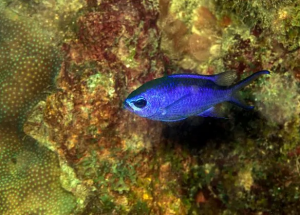
The Blue Chromis (Chromis cyaneus) is a favorite of saltwater enthusiasts. Blue fish are beautiful and active.
With a maximum growth of four inches, the blue chrome is quiet and easy to maintain.
In nature they are alone and in schools. A group of three can be kept in a 15 gallon aquarium. Being an active fish with bright blue colors, they stand out in a small aquarium.
They are compatible with this list of dwarf fish outlined in this article. Feed these reef-loving fish a combination of meaty and herbivorous foods.
7. Neon Goby

Known as “perching fish” or “cleaning fish”, neon gobies display a great mix of personality as they swim around inside a tank.
Sometimes they park on the pelvic fins, flat stomachs along the chosen area on the ground.
They often wait for food to float around them or for a larger fish to pass. Neon gobies eat the small dirt or algae that attaches to the body of larger fish.
8. White Banded Possum Wrasse

You may have already heard of Six-Line Wrasse that has the iris marks- popular with marine aquarists. Unfortunately, this fish requires a much larger tank than the white-banded wrasse described here.
The latter grows only 2 ½ inches in length and has a dusty red body with vertical white stripes. Two white bands cross the fish’s irises, which are black with a red inner circle. The white-edged black eye spots on the upper and lower fins give this fish a mysterious and charming look without being too bright or over the top.
The white banded wrasse is a fairly small, attractive and peaceful fish that will do well in most dwarf aquariums. Its color and patterns are unique and will create interest in your aquarium.
9. Royal Gramma

This fish is known as royal for its vibrant purple and yellow color throughout its body, which symbolizes royalty in ancient times.
The king gramma prefers to inhabit the rock and coral formations within the tanks. They also give you a nice variety of colors when swimming in the water.
10. Dartfish or Firefish Goby
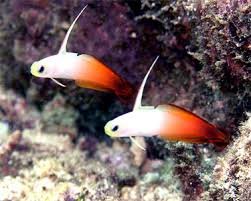
A favorite in the goby family would be the dart fish or fire pike goby, which displays a charming and innocent appearance along with its body colored often in purple or orange hues.
What makes it even more unique is the additional fin near its head which is customarily adapted for fishing while swimming.
11. Helfrichi Firefish
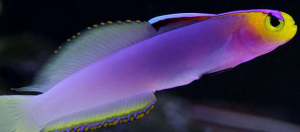
This is an absolutely stunning long-bodied fish. It has a hint of bright yellow color on the nose and extends for about half of the gill coverage. After that, it quickly changes to a deep violet that fades to a pastel, almost luminescent lilac.
The caudal fin is tricolor with white, black and red stripes. Their anal fin is translucent and then edged in yellow, blue, and orange. Finally, it has a pastel yellow tail with some lemon yellow streaks.
This fish is fairly easy to care for and a good choice for beginners. While it may be territorial, it compensates for it with beautiful colors and a personality to match.
12. Fire Dartfish

Target fish include firefly species (Nemateleotris) and target fish (Ptereleotris). Some species require a larger non-dwarf aquarium containing live marine plants and a debris bottom.
The Firefish goby is a reef compatible fish suitable for nano aquariums.
These fish grow up to three inches in length. The pointed dorsal fin together with the orange, red and white coloring make it an amazing fish.
Fire fish prefer a rocky aquarium with caves to hide in. If you keep one type of fish, various fire fish make an interesting exhibit. Darts fish are compatible with other nano fish, but care must be taken if you keep a bass or chromium in a small aquarium.
They are carnivorous and require a vitamin-rich diet of brine shrimp and mysis to maintain their bright coloration.
13. Clownfish (Ocellaris Clownfish)
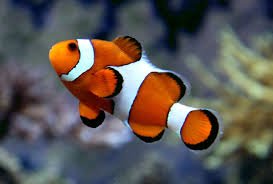
Being famous in the movie “Finding Nemo”, the clownfish begins to be in great demand in aquariums, especially in nano tanks.
Being territorial when they are breeding will be a problem with having other fish in the tank. Therefore, it is advisable to put only one pair in a small tank.
A couple of clownfish in a small tank gives a great look! They are active fish that will entertain viewers as they swim around together. (Read our article on Clownfish tank setup)
14. Blue Chromis

Blue Chromis are very popular with nano reef aquariums. You can feed them plenty, however, they remain small.
Their gorgeous blue color makes them a standout and having them in a school is even better. They are a social, schooling fish and will be more comfortable in a group.
They can be delicate. Water quality is important for these fish.
15. Green Chromis

Like its cousin, the Blue Chromis, Green Chromis also performs best when grouped.
You will enjoy its perfect green coloring in the delicate tub lighting. Although they can argue with other species, they are still considered tough and may last longer than others.
Final thoughts – Best Nano Saltwater Fish For Your Nano Reef Tank
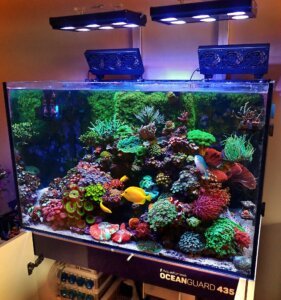
Selecting the best nano saltwater fish for your nano reef tank requires careful planning. Do some research on compatibility and fish needs.
Nano reef fish are very beautiful and interesting to look at. Their small size makes it tempting to add too many to an aquarium, however keep in mind that most dwarf fish need space to develop their territory.
If they feel crowded, they can fight or become stressed and be susceptible to disease. When maintaining a nano reef aquarium, much of the attention is paid to the colorful corals.
Adding a dwarf fish or two adds movement and interest. If your nano aquarium is just for fish, consider adding a piece of live rock or building a cave- a place for your fish to hide.
Just because the aquarium is small does not mean it requires less care than a large aquarium. In fact it will require more attention. With a little pre-thought and attention to care you’ll have a beautiful aquatic gem that you can display in your home or office.
Now that you have an idea of what types of fish to buy from your local pet store, it’s best to accumulate knowledge about the characteristics of the fish before making the purchase. These are the key points to take note of:
Key Points
- Make sure the fish are kept small in their adult form.
- Based on fish needs, ensure they have the required space to swim and have a territory (especially if they want to breed).
- Regardless of the type of fish you select, remember to maintain water quality and feed premium food.
- Provide places for the fish to retreat and hide if they need to.
- Ensure the tank has sufficient filters and heating.
Here’s to wishing you every success in selecting the best nano saltwater fish for your nano reef tank!
.

